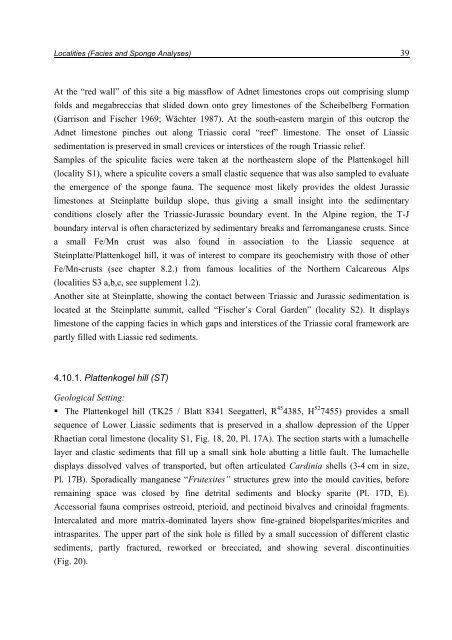Porifera-microbialites of the Lower Liassic (Northern Calcareous ...
Porifera-microbialites of the Lower Liassic (Northern Calcareous ...
Porifera-microbialites of the Lower Liassic (Northern Calcareous ...
You also want an ePaper? Increase the reach of your titles
YUMPU automatically turns print PDFs into web optimized ePapers that Google loves.
Localities (Facies and Sponge Analyses) 39<br />
At <strong>the</strong> “red wall” <strong>of</strong> this site a big massflow <strong>of</strong> Adnet limestones crops out comprising slump<br />
folds and megabreccias that slided down onto grey limestones <strong>of</strong> <strong>the</strong> Scheibelberg Formation<br />
(Garrison and Fischer 1969; Wächter 1987). At <strong>the</strong> south-eastern margin <strong>of</strong> this outcrop <strong>the</strong><br />
Adnet limestone pinches out along Triassic coral “reef” limestone. The onset <strong>of</strong> <strong>Liassic</strong><br />
sedimentation is preserved in small crevices or interstices <strong>of</strong> <strong>the</strong> rough Triassic relief.<br />
Samples <strong>of</strong> <strong>the</strong> spiculite facies were taken at <strong>the</strong> nor<strong>the</strong>astern slope <strong>of</strong> <strong>the</strong> Plattenkogel hill<br />
(locality S1), where a spiculite covers a small clastic sequence that was also sampled to evaluate<br />
<strong>the</strong> emergence <strong>of</strong> <strong>the</strong> sponge fauna. The sequence most likely provides <strong>the</strong> oldest Jurassic<br />
limestones at Steinplatte buildup slope, thus giving a small insight into <strong>the</strong> sedimentary<br />
conditions closely after <strong>the</strong> Triassic-Jurassic boundary event. In <strong>the</strong> Alpine region, <strong>the</strong> T-J<br />
boundary interval is <strong>of</strong>ten characterized by sedimentary breaks and ferromanganese crusts. Since<br />
a small Fe/Mn crust was also found in association to <strong>the</strong> <strong>Liassic</strong> sequence at<br />
Steinplatte/Plattenkogel hill, it was <strong>of</strong> interest to compare its geochemistry with those <strong>of</strong> o<strong>the</strong>r<br />
Fe/Mn-crusts (see chapter 8.2.) from famous localities <strong>of</strong> <strong>the</strong> Nor<strong>the</strong>rn <strong>Calcareous</strong> Alps<br />
(localities S3 a,b,c, see supplement 1.2).<br />
Ano<strong>the</strong>r site at Steinplatte, showing <strong>the</strong> contact between Triassic and Jurassic sedimentation is<br />
located at <strong>the</strong> Steinplatte summit, called “Fischer’s Coral Garden” (locality S2). It displays<br />
limestone <strong>of</strong> <strong>the</strong> capping facies in which gaps and interstices <strong>of</strong> <strong>the</strong> Triassic coral framework are<br />
partly filled with <strong>Liassic</strong> red sediments.<br />
4.10.1. Plattenkogel hill (ST)<br />
Geological Setting:<br />
� The Plattenkogel hill (TK25 / Blatt 8341 Seegatterl, R 45 4385, H 52 7455) provides a small<br />
sequence <strong>of</strong> <strong>Lower</strong> <strong>Liassic</strong> sediments that is preserved in a shallow depression <strong>of</strong> <strong>the</strong> Upper<br />
Rhaetian coral limestone (locality S1, Fig. 18, 20, Pl. 17A). The section starts with a lumachelle<br />
layer and clastic sediments that fill up a small sink hole abutting a little fault. The lumachelle<br />
displays dissolved valves <strong>of</strong> transported, but <strong>of</strong>ten articulated Cardinia shells (3-4 cm in size,<br />
Pl. 17B). Sporadically manganese “Frutexites” structures grew into <strong>the</strong> mould cavities, before<br />
remaining space was closed by fine detrital sediments and blocky sparite (Pl. 17D, E).<br />
Accessorial fauna comprises ostreoid, pterioid, and pectinoid bivalves and crinoidal fragments.<br />
Intercalated and more matrix-dominated layers show fine-grained biopelsparites/micrites and<br />
intrasparites. The upper part <strong>of</strong> <strong>the</strong> sink hole is filled by a small succession <strong>of</strong> different clastic<br />
sediments, partly fractured, reworked or brecciated, and showing several discontinuities<br />
(Fig. 20).

















